Complete Guide to the Bear Lake Loop Hike – The Most Accessible Hike in Rocky Mountain National Park
The Bear Lake area is one of the most-visited destinations in Colorado’s Rocky Mountain National Park, yet also one of the most overlooked! You may be wondering how that can be – if everyone is going there, how can it be overlooked? Well here’s the thing: the Bear Lake Trailhead marks the start of several popular hikes in the park, and a lot of hikers are so eager to get on the trail that they skip spending time at Bear Lake itself. Don’t let that be you!
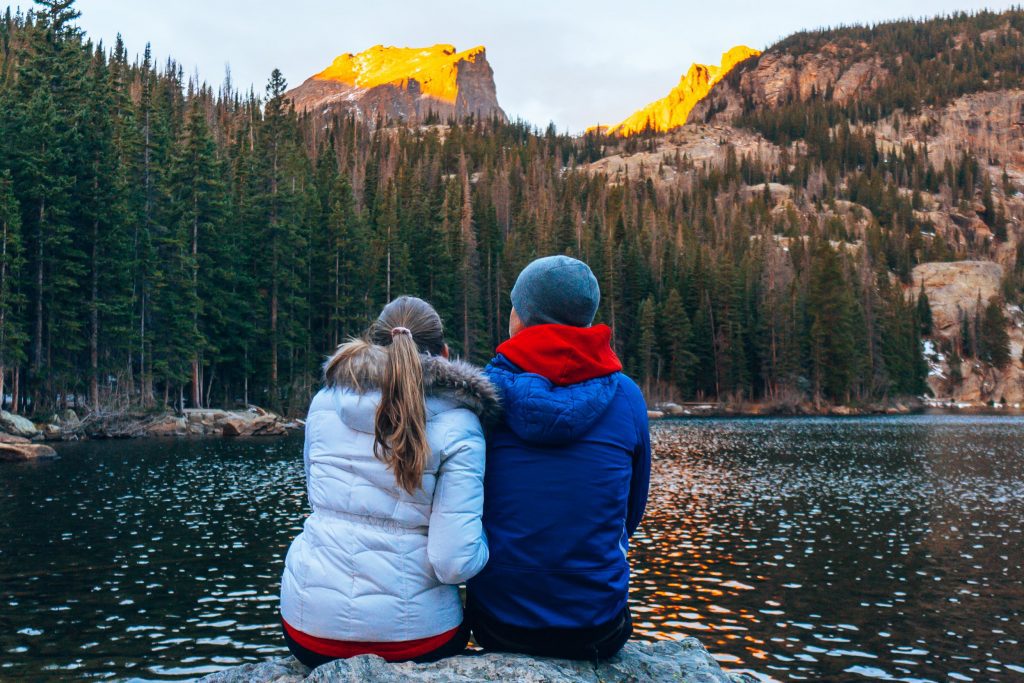
Whether you opt to do the full loop hike around the lake, or just walk to the lakeshore for a quick view, make sure you put Bear Lake on your Rocky Mountain National Park bucket list!
Bear Lake is one of the most accessible lakes in the national park, suitable for all ages and hiking skill levels. The walk to the lake from the parking area is short and sweet. To be honest, the only hard thing about seeing Bear Lake is getting a timed-entry permit for Bear Lake Road in peak season! Don’t worry though! Our comprehensive guide to all things Bear Lake will tell you everything you need to know to prep for your visit to this iconic destination in Colorado’s Rocky Mountain National Park!
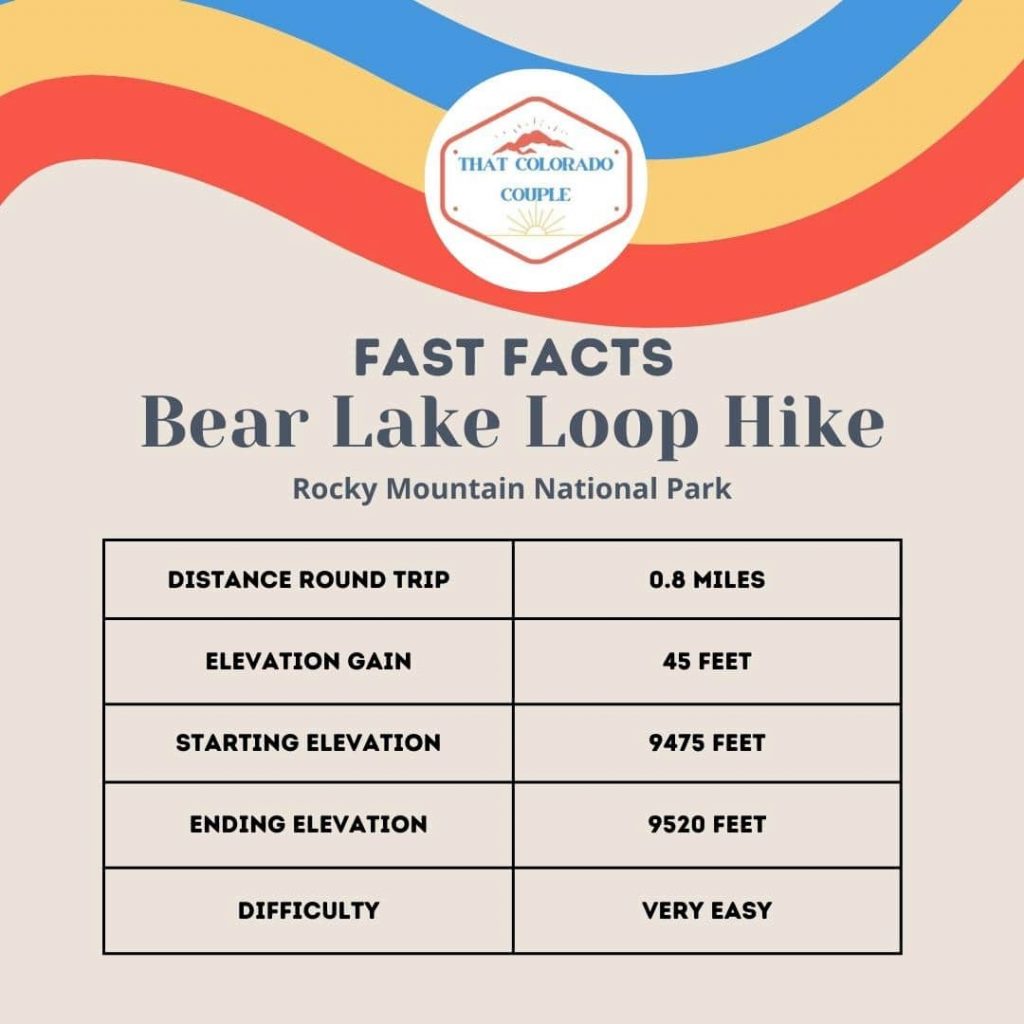
Bear Lake Geology
Bear Lake is a stunning alpine lake that sits beneath views of Hallett Peak and the Continental Divide at 9,450 feet of elevation above sea level. Like many lakes in Colorado, Bear Lake was formed during the last Ice Age when a glacier carved out the bowl that is now the lake! You can still see the glacial moraine downhill from the lake. If you haven’t seen moraine before, it’s basically the debris leftover from when glaciers move through an area and then melt away. Because the glaciers pick up rocks along the way, when the glaciers eventually melt, they leave the rocks behind. The debris that comprises the moraine can be as big as boulders or as small as tiny pebbles or even sand.

Bear Lake History
I hate to break the news to you but you probably WILL NOT see any bears at Bear Lake. Bear Lake got its name in 1912, at a time when both black and grizzly bears lived in what is now Rocky Mountain National Park. Fewer than 50 black bears still live in the park, while grizzlies have been extinct there for over a century. Still, the lake maintains its name – just don’t get your hopes up about actually seeing any bears there!
How to get to Bear Lake
Bear Lake is located inside Rocky Mountain National Park approximately 13 miles from the town of Estes Park. You will want to enter the national park at the Beaver Meadows Entrance. From there, it takes about 20 minutes to drive to Bear Lake. You’ll arrive at a large parking area, but plan to arrive early because it fills up fast!

Park Entrance Fee
The first thing you need to know about visiting Bear Lake is that you will need to pay $30 for the Rocky Mountain National Park Entrance Fee. Alternatively, you can use your annual national parks pass like America the Beautiful Pass. This annual pass gets you entry to over 2,000 locations in the United States National Park system at no additional cost beyond the upfront payment for the pass. We get one every year and highly recommend it if you’re planning to visit 3 or more national park sites in a 12-month period.
Timed Entry Permit for Bear Lake
The second thing you need to know about visiting Bear Lake is that during the summer months between May and October, a timed-entry permit is required to access Bear Lake Road Corridor. And yes, Bear Lake is on this corridor. When you go to recreation.gov to obtain your permit, you will want to make sure to select Option 1 for Bear Lake Road access.
Another important thing to know is that even if you are NOT planning to visit Bear Lake Road, you still need a timed-entry permit to visit Rocky Mountain National Park during those same months. For general access to RMNP between May and October, excluding the Bear Lake Road area, you’ll want to select Option 2 when booking your timed-entry permit.
You can technically avoid getting either permit IF you enter the park outside of the timed-entry permit hours. To visit Bear Lake, this means you need to arrive before 5 AM or after 6 PM if you do not have a timed-entry permit.
Hiker Shuttle
If you can’t get a timed-entry permit and you don’t want to wake up at an ungodly hour to get into the park, you do have one more option! Rocky Mountain National Park offers a hiker shuttle that can pick you up at the Estes Park Visitor Center and drop you off at numerous trailheads within the park, including Bear Lake! Just make sure you also buy your shuttle pass in advance so you are prepared when you arrive! You can obtain the hiker shuttle pass here.
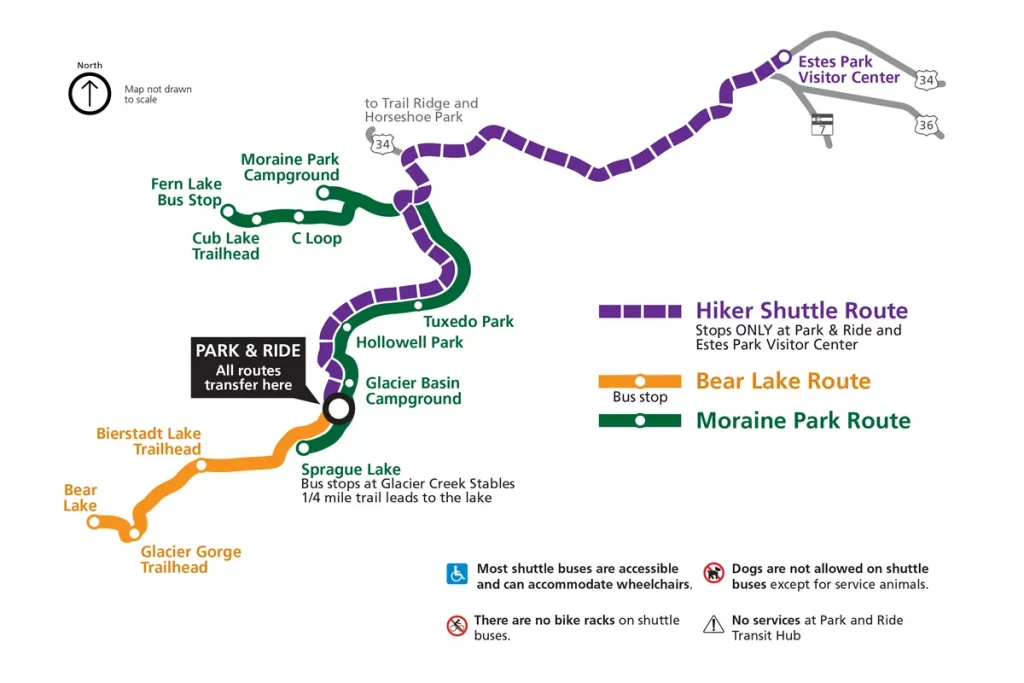

Weather at Bear Lake
While Bear Lake is accessible year-round, you’ll want to keep these typical weather conditions in mind when determining the right time for YOU to visit!

Summer
The most reliably “good” weather at Bear Lake is during the summer months when temperatures are warm and mornings are generally sunny and clear. That said, it’s important to know that during the summer, afternoon thunderstorms roll in pretty much every day. We always recommend finishing your hikes in the Rocky Mountains before noon during the summer.
Fall
In the fall, you’ll be gifted with gorgeous foliage as the leaves change color, but may have more erratic weather. The lakes, including Bear Lake, in Rocky Mountain National Park, will typically be frozen by the beginning of November, and trails will start to accumulate snow.
Winter
In winter, Rocky Mountain National Park is COLD and snow-covered. You’ll definitely want to have microspikes or snowshoes if planning to hike in RMNP in the winter.
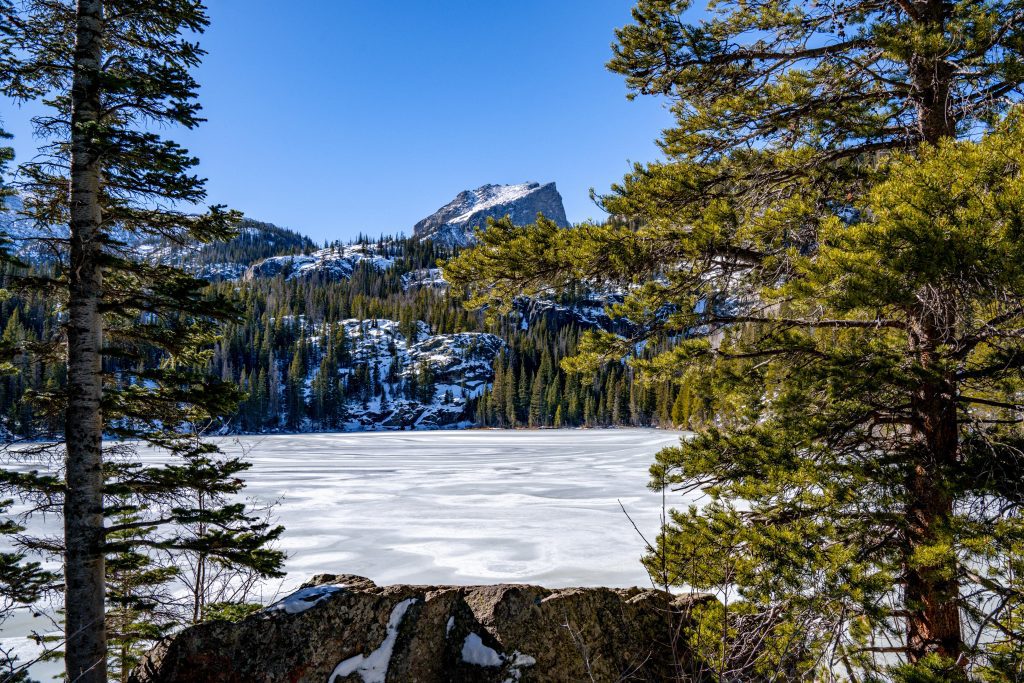
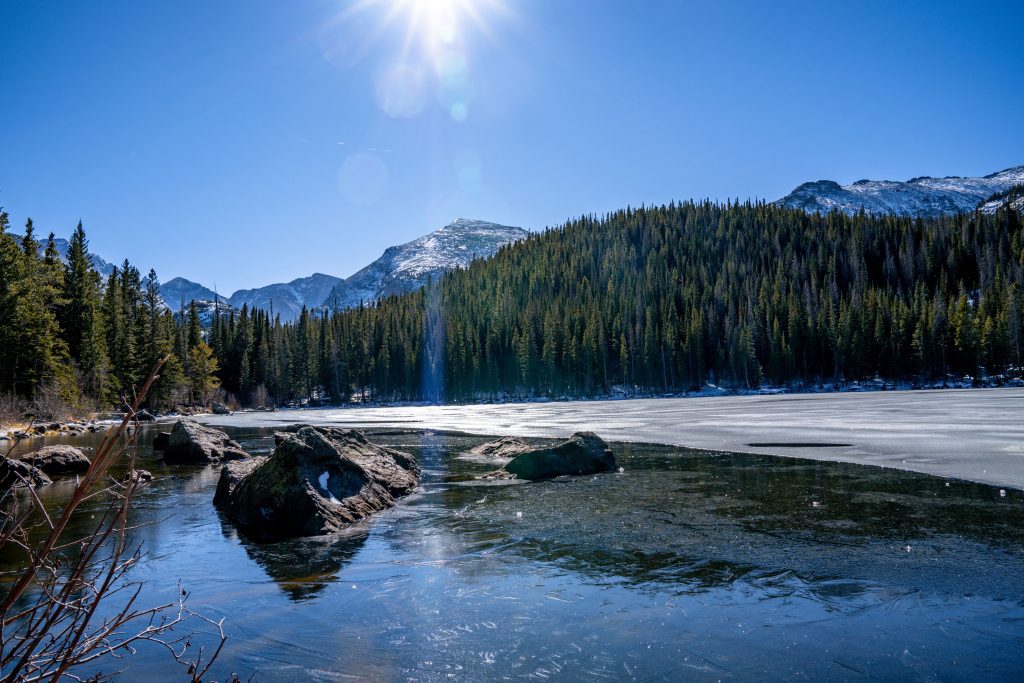
Spring
In spring, trails may be muddy as snow melts. That said, the path to Bear Lake is firm, packed dirt so whether you are visiting in spring, summer, fall, or winter, you should be able to fairly easily make your way to the lakeshore. Still, we recommend microspikes if temps are below 32 degrees Fahrenheit (as in, below freezing) because the path may be icy and you don’t want to slip!
Average Temperatures in Rocky Mountain National Park
Below is a table of average high and low temperatures at Bear Lake Trailhead throughout the year to help you plan!

Altitude Sickness
If you are visiting Colorado from an area with lower elevation relative to sea level (and let’s be real, chances are unless you live in Colorado, this is you!), you will likely experience some impacts of altitude sickness. Symptoms include headaches, shortness of breath, lack of appetite, and fatigue. We recommend spending a few days at lower elevations, such as Denver, before coming up to the mountains. This is especially true if you are planning to hike.
That said, because you can visit Bear Lake without having to do a strenuous hike, Bear Lake is a great option if you aren’t feeling well and don’t have extra days to spend acclimating to the altitude.
The best thing to do in the meantime while experiencing altitude sickness is to treat your symptoms, get lots of rest, and drink a lot of water! In a day or two, you should feel much better!

Bear Lake Hikes
To see Bear Lake, you have three general options. We outline each below!
Walk the short (0.1 miles) packed dirt path to Bear Lake
Five minutes from the time you park your car or hop off the shuttle at Bear Lake Trailhead, you can be at the shore of Bear Lake. From this first view over the lake, you can see Hallett Peak and Flattop Mountain looming above. There are a few info boards with more details about the lake and its geology.

Hike the loop trail around Bear Lake
An easy 0.5-mile trail loops around the entirety of Bear Lake. With only 49 feet of elevation gain, this is a serene and pleasant walk from which you can take in 360-degree views of Bear Lake! This trail is firm, packed with dirt, and accessible year-round. In winter, I recommend using microspikes since the trail stays pretty much COVERED in snow from November to May!

When I hiked the Bear Lake Loop, I went counterclockwise, but you can go either direction. Going counterclockwise, you’ll come to a signpost for various other trails (including Bierstadt Lake and Flattop Mountain) branching off to the right. Keep going straight to stay on the Bear Lake Loop.
Along the way, there are several areas to stop and enjoy the view of Bear Lake, including plenty of benches if you want to sit and relax for a bit!
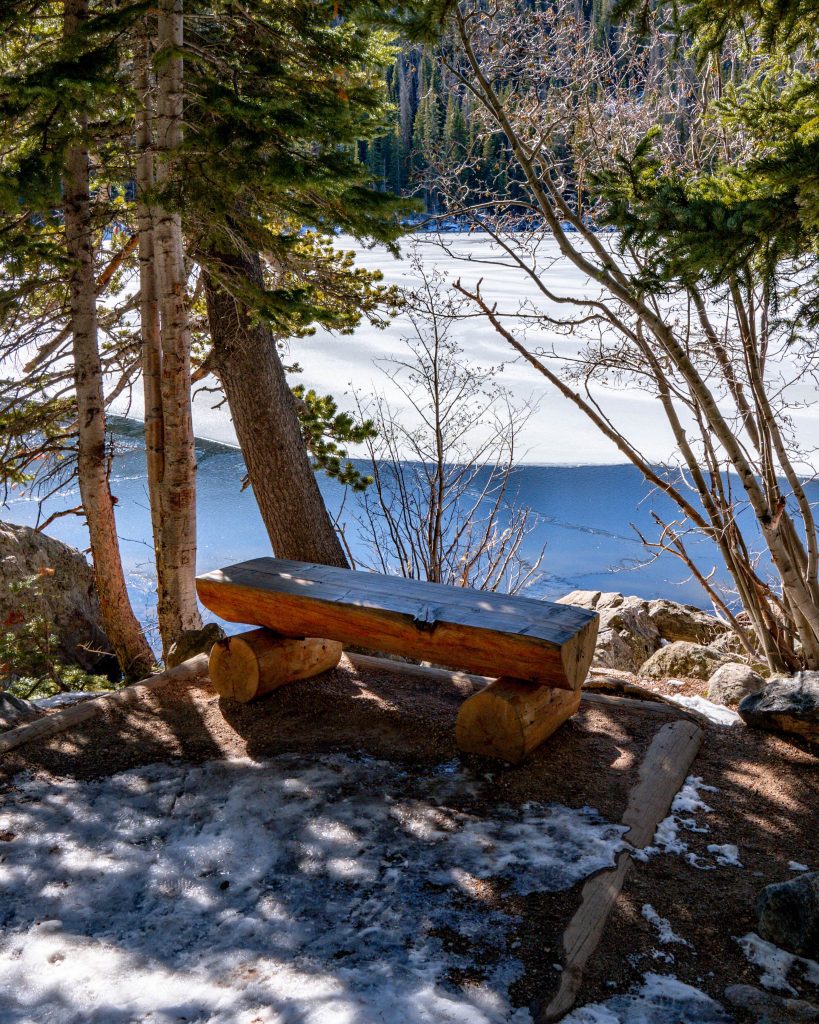
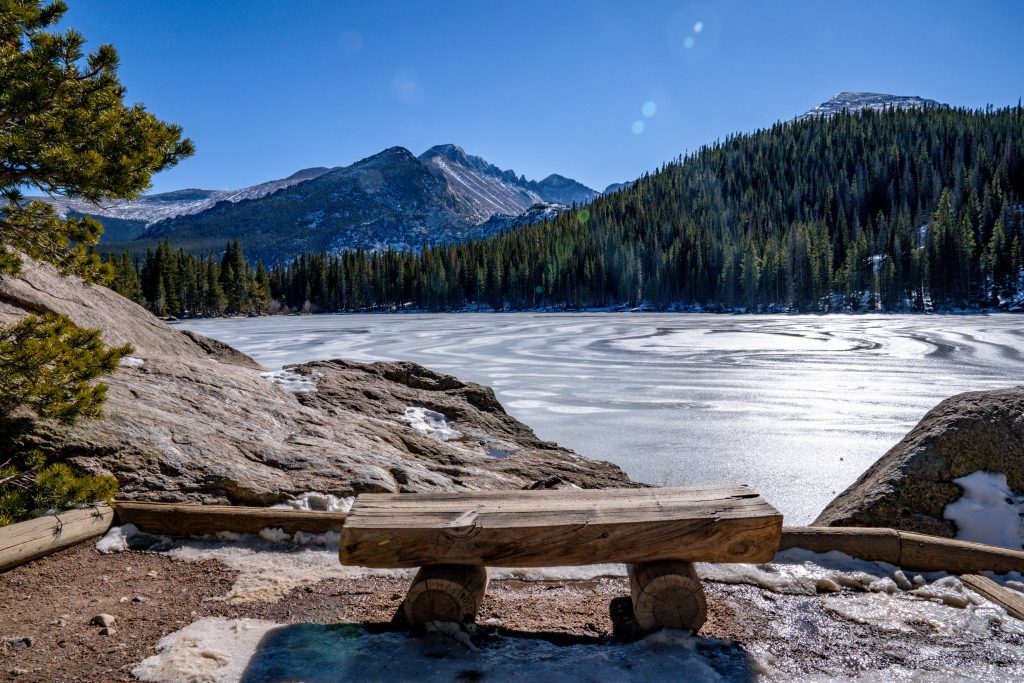
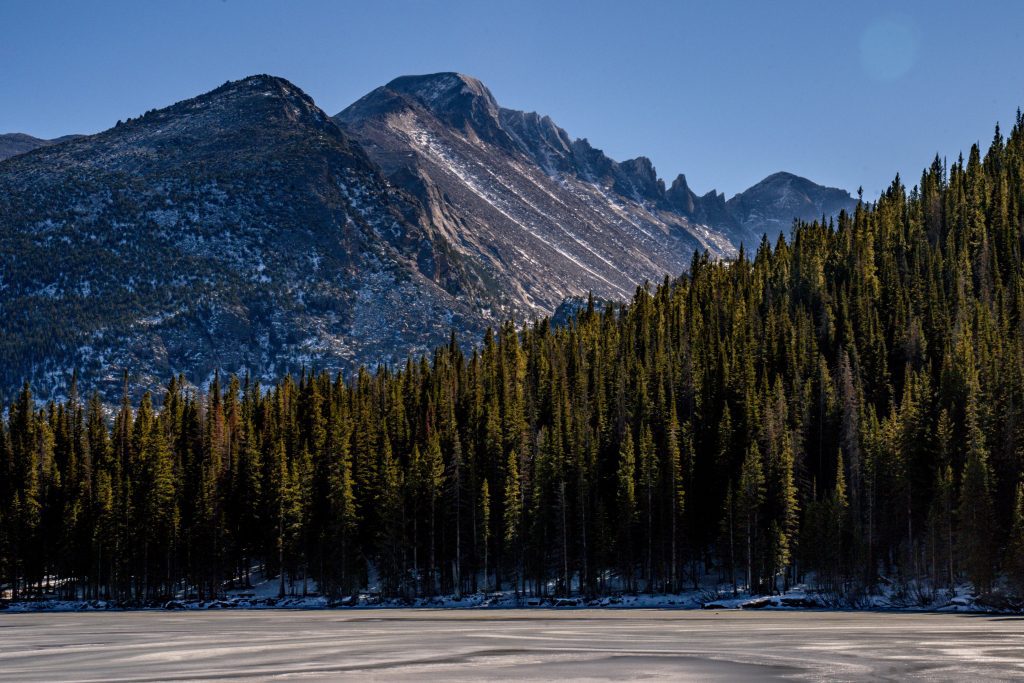
The best view of Bear Lake, in my opinion, is along the first half of the loop when you get views of the mountains to the west. Eventually, you curve around and hike through a more forested portion of the trail with views of the forest across the lake.
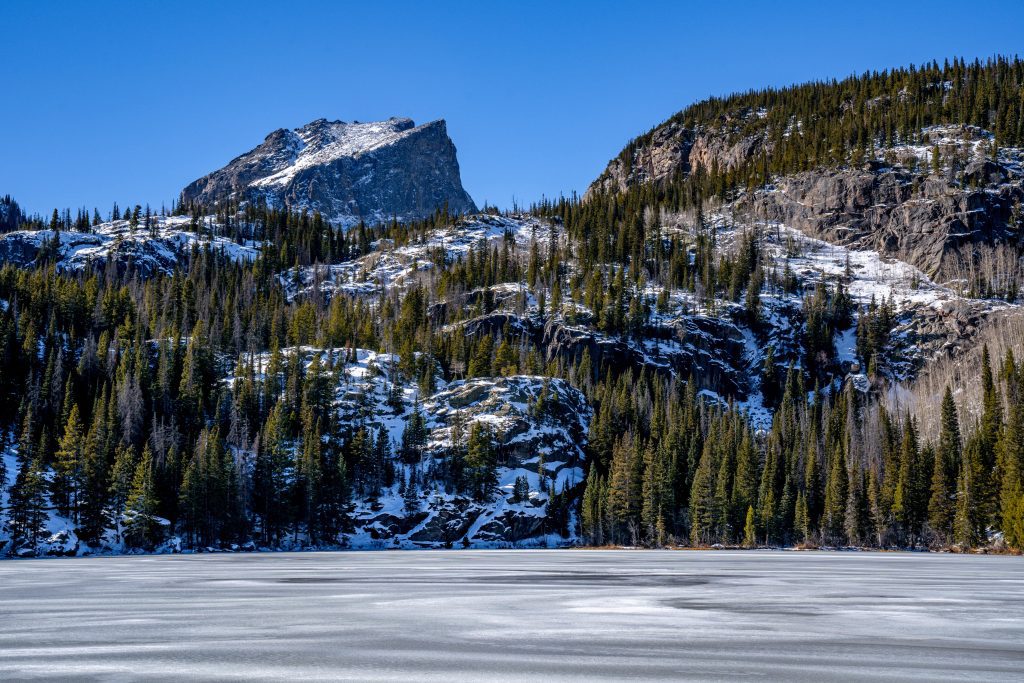
As you near the trailhead where you began, you’ll cross over a short wooden bridge. Once you get to this point, it’s just another minute or so of walking before you’ll arrive back at the start of the loop!
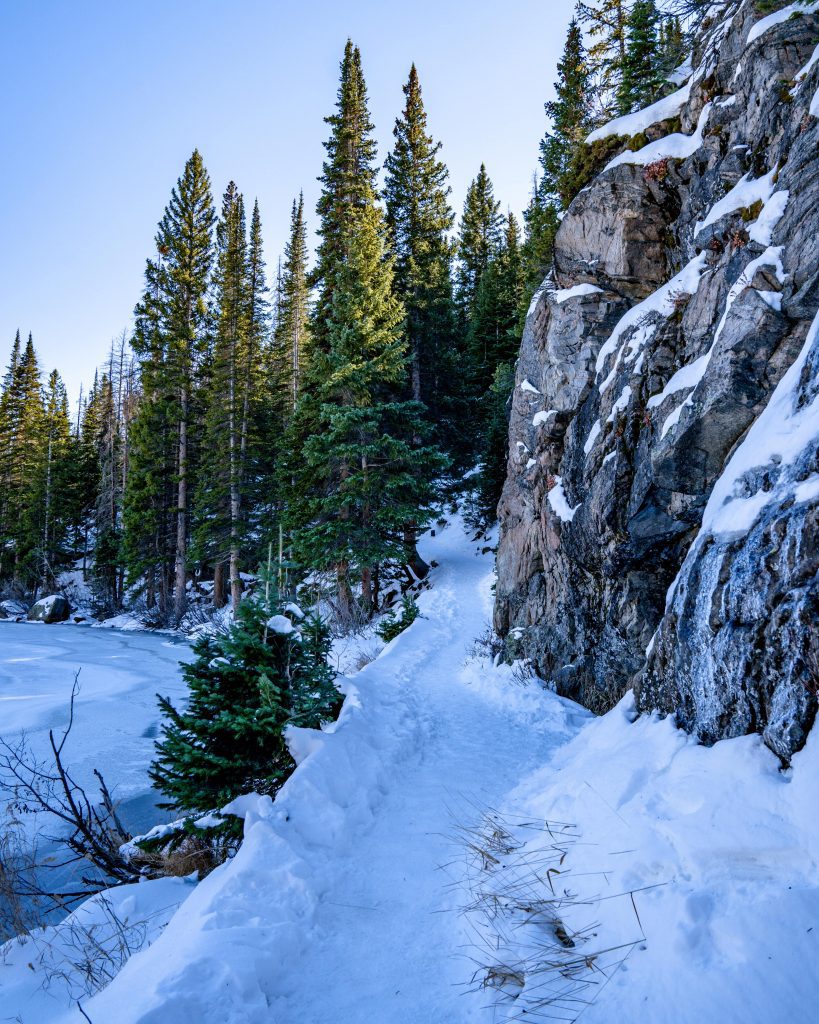
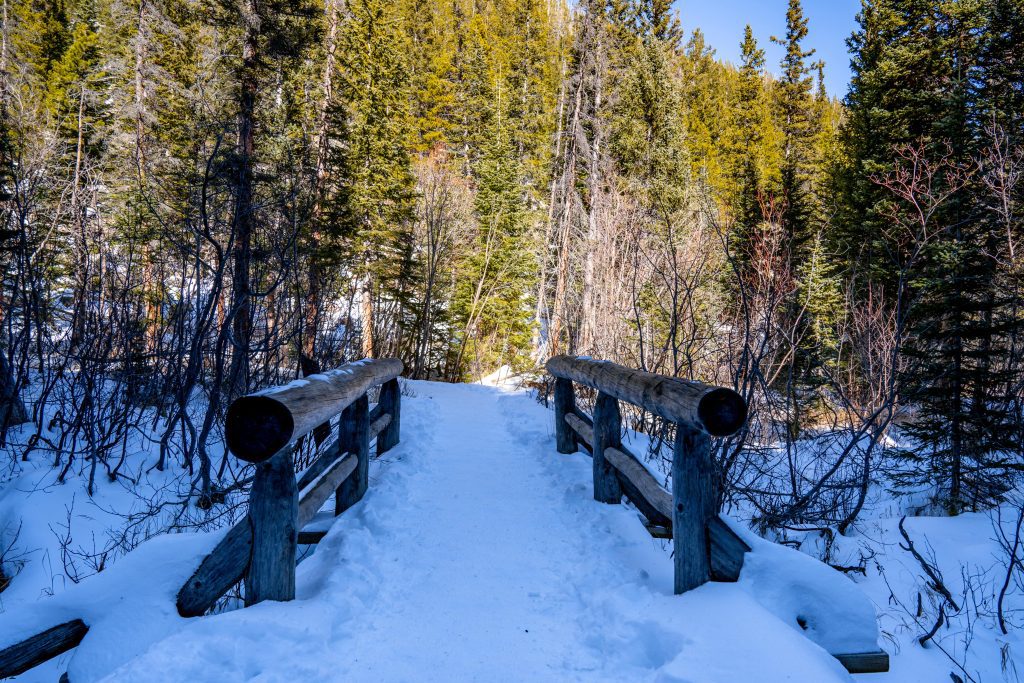
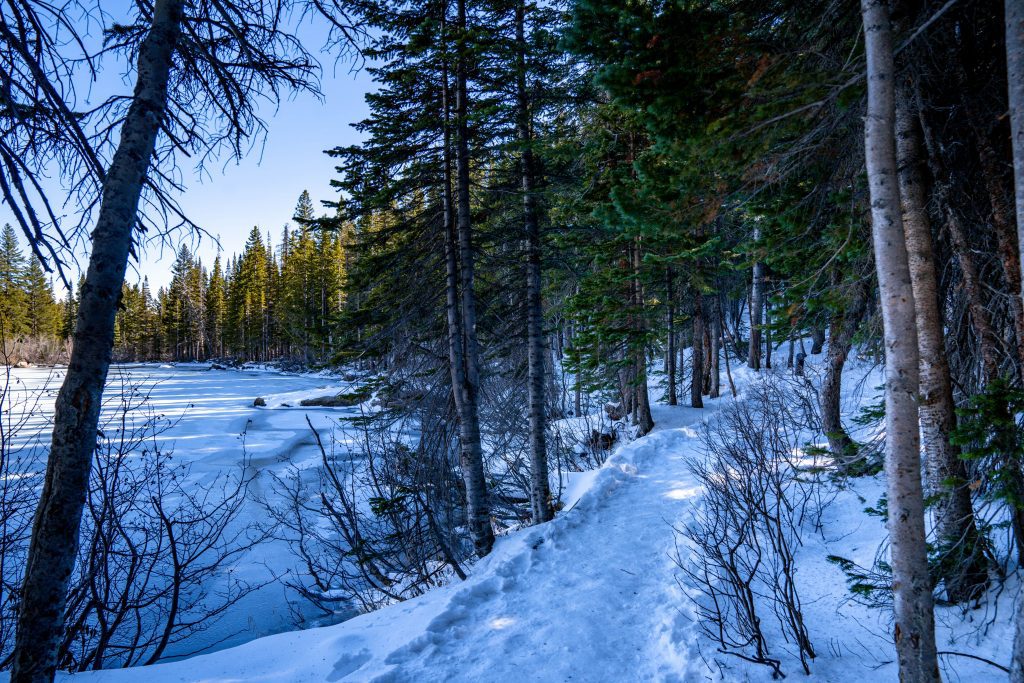
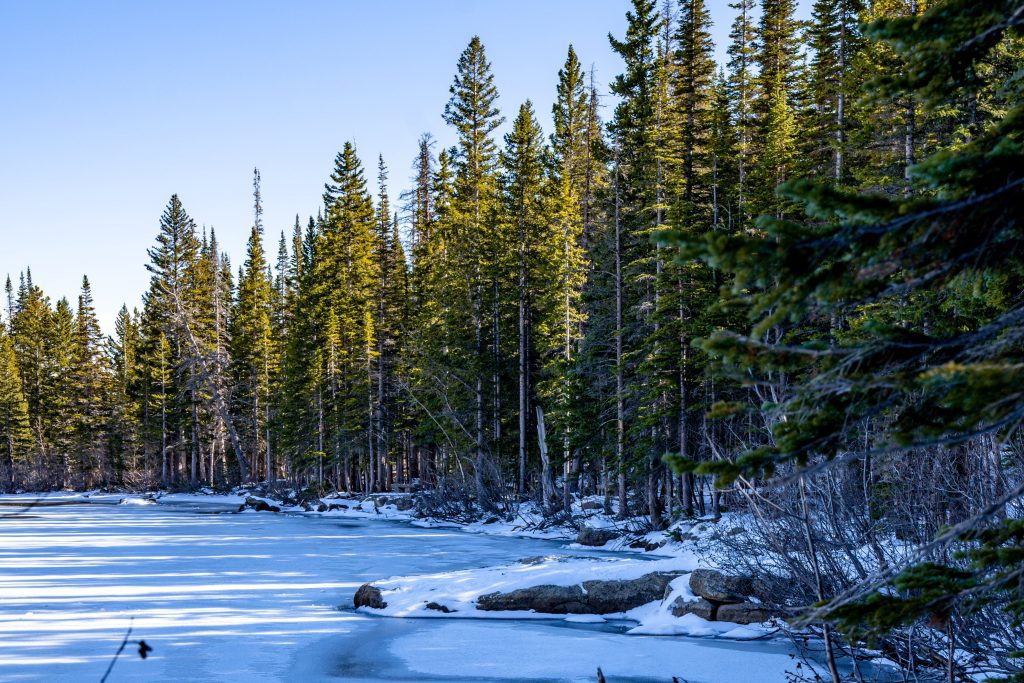
Detour to Bear Lake on a longer hike from the Bear Lake trailhead
There are many longer hikes you can take from the Bear Lake trailhead, the most popular being Emerald Lake and Lake Haiyaha. Whichever hike you’re tackling, be sure to take the short path to Bear Lake on your right as you start your hike from the trailhead, or your left when you return to the parking area. Be sure to check out our blog post about the various hiking options you can choose from Bear Lake trailhead. It really is a “choose your own adventure” kind of destination!
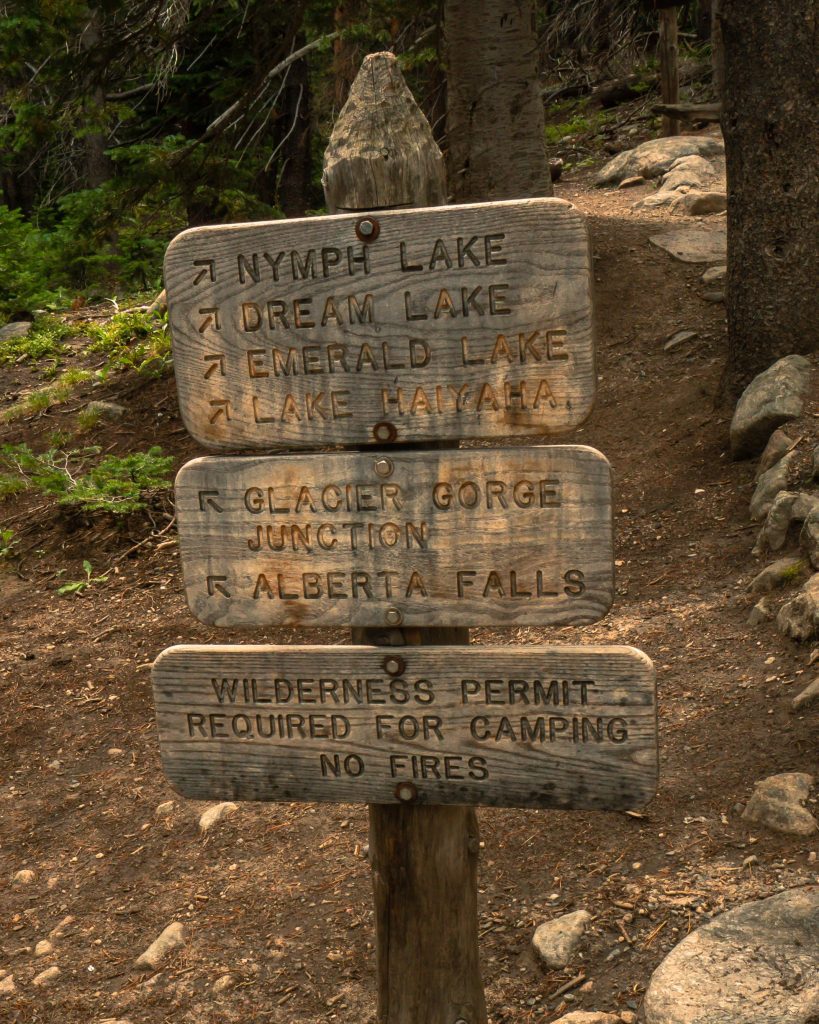
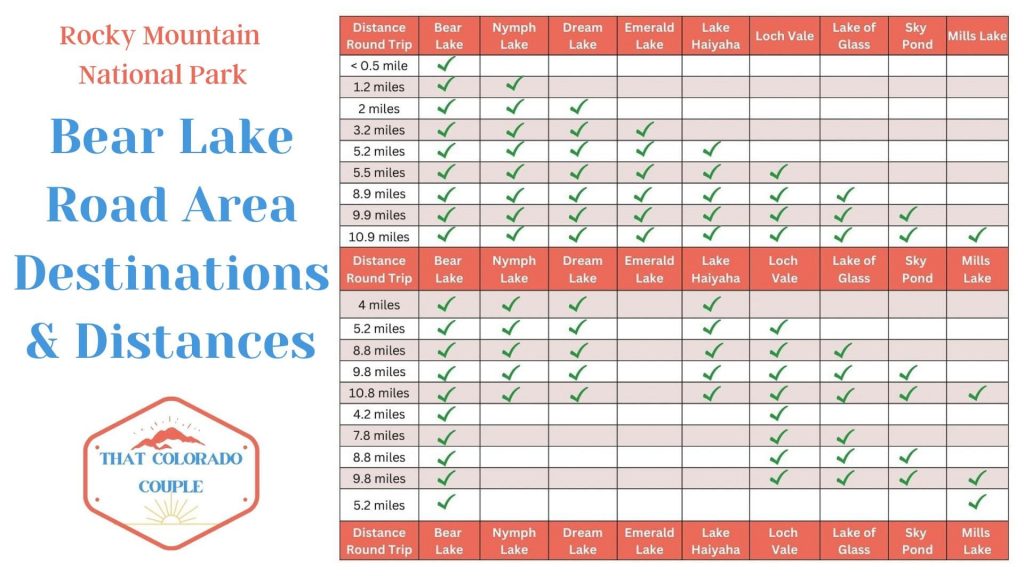
What to Wear/Pack
Unless you are planning to do a longer hike in addition to Bear Lake, you need minimal gear. Here are the basics we recommend:
- Sun Protection: This is so important in the mountains where the thin air makes the sun’s rays more powerful. Even on short hikes or periods outside, you’ll want to make sure you have sun protection! Sun Bum is our favorite sunscreen brand.
- Sunglasses: I love these wooden frame sunglasses, so they are my go-to.
- Jacket: Even in summer it can be really chilly on Rocky Mountain National Park’s lakes! I always pack my Columbia jacket when hiking in the mountains.
- First Aid Kit: An ultralight first aid kit is a must-have for every hike. You never know what can happen, and you’ll be glad to have a first aid kit if you need one!
- Camera: I always hike with my Sony a7iii. It’s a great full-frame camera for capturing all of our hiking memories!
- Snacks: Clif Energy Bars are our favorite snack for road trips and national park visits. It’s got the perfect mix of carbs, fats, and protein to power us through big days exploring!
- If you’re visiting Bear Lake in winter, you’ll absolutely want to bring a pair of microspikes with you. These will slide over your boots and keep you from slipping on icy portions of the trail and even the parking lots! Trust us, you’ll be able to enjoy your visit to Bear Lake so much more if you aren’t worried about falling on the ice!
If you are planning on hiking to Emerald Lake, Lake Haiyaha, or any of the other destinations from Bear Lake Trailhead, we recommend these additional items:
- Day Pack: It’s so helpful to have a good day pack to carry everything you need. I’ve had the Osprey Skimmer 20 for Women for years and it’s held up on every adventure! And here’s the Osprey Talon 22 Pack for Men!
- Water Reservoir: If your day pack doesn’t have a water reservoir in it already, you can buy one separately to slip into your bag. It’s absolutely NECESSARY that you bring water with you on every hike. Here are our favorite 2-liter reservoir and 3-liter reservoir!
- Hiking Boots: I pretty much always hike in my Columbia hiking boots. I literally have these in multiple colors because I love them so much! You can’t beat the price for the quality, too. Tim is always wearing his Foxelli boots and swears they are the best hiking boots he’s ever owned. He also has multiple pairs on stand-by in his closet for when the tread on these finally wears out (though it’s been a few years and they are still going strong!).
- Socks: I started wearing these double-layer Wrightsock brand socks when marathon training years ago and have never gotten a blister with them! In winter, I might mix it up with merino wool socks, too.
- Hiking pants: These hiking leggings are my favorite in winter. In summer, I usually hike in biker shorts or leggings.
- Moisture-wicking layers: SmartWool is our favorite layering brand. I wear this pullover all the time (it went around the world with us in 2014 and is still in great condition) and their wool t-shirts are great base layers. There are also SmartWool t-shirts for men!
- Trekking poles: Many people like hiking with trekking poles to reduce the impact on the knees, especially going downhill. We don’t use ours often, but these Black Diamond Trail Back hiking poles are really popular!
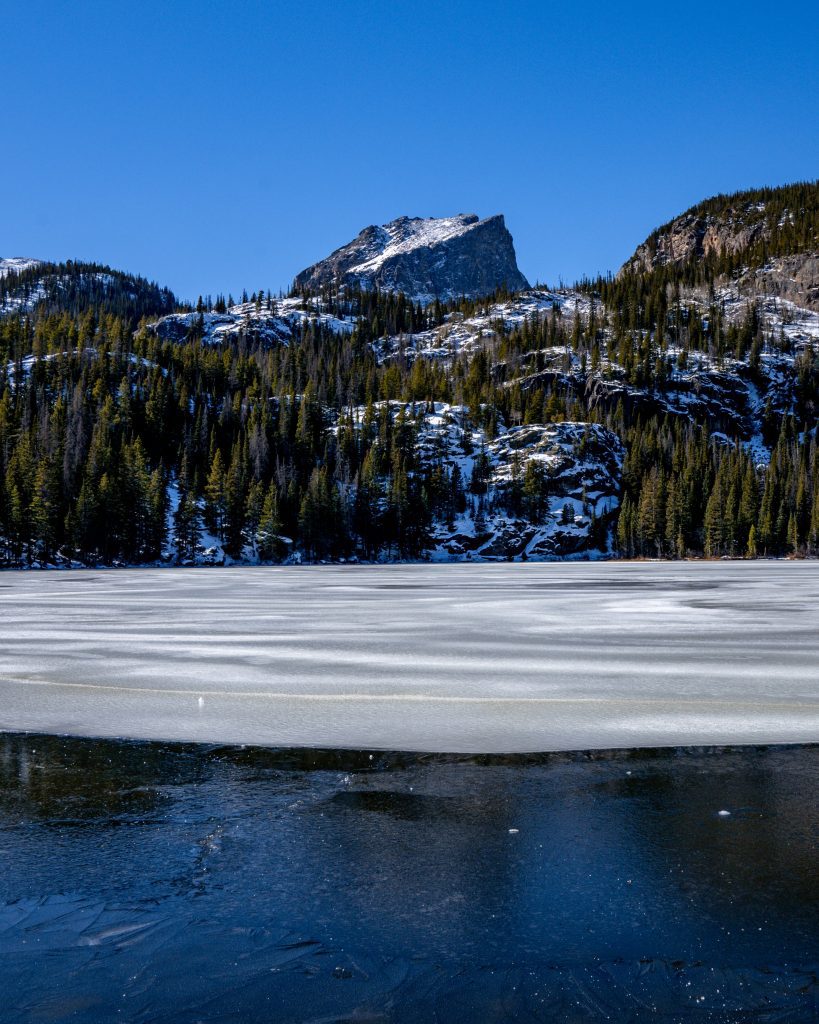
Where to Stay in Estes Park
We recommend basing yourself in Estes Park when visiting Rocky Mountain National Park. Here are some well-rated hotel options in Estes Park, which is just a few miles from the Beaver Meadows entrance station to RMNP.
Luxury
Midrange
- The Historic Crag’s Lodge
- Silver Moon Hotel
- Best Western Plus Silver Saddle Inn
- 4 Seasons Inn on Fall River
- Hotel Estes
Budget
Click here to search for additional hotels in Estes Park or search below!
Guided Tours in Rocky Mountain National Park
If you prefer guided tours to going on your own, check out these options. There are several hiking and sightseeing tours in Rocky Mountain National Park you can choose from. Many will include Bear Lake, but be sure to read the tour itinerary closely to make sure it covers what you’d like to see!
Final Thoughts on Bear Lake
Before you go, make sure you check out our other guides to Rocky Mountain National Park, and don’t forget to get your annual national parks pass for easy entrance to RMNP and over 2,000 other locations in the United States!
- Bear Lake Trail Network – Explained!
- Emerald Lake Hike
- Lake Haiyaha Hike
- Loch Vale Hike
- Sky Pond Hike
- Chasm Lake Hike
- Trail Ridge Road Scenic Drive
We hope this post has convinced you to give Bear Lake more than just a passing glance when you visit Rocky Mountain National Park! Whether you just visit the first viewpoint of the lake, circumnavigate Bear Lake on the loop trail, or make Bear Lake one of your stops on a longer hike in the area, you will not be disappointed with the beautiful Rocky Mountain views from this iconic destination in RMNP!







